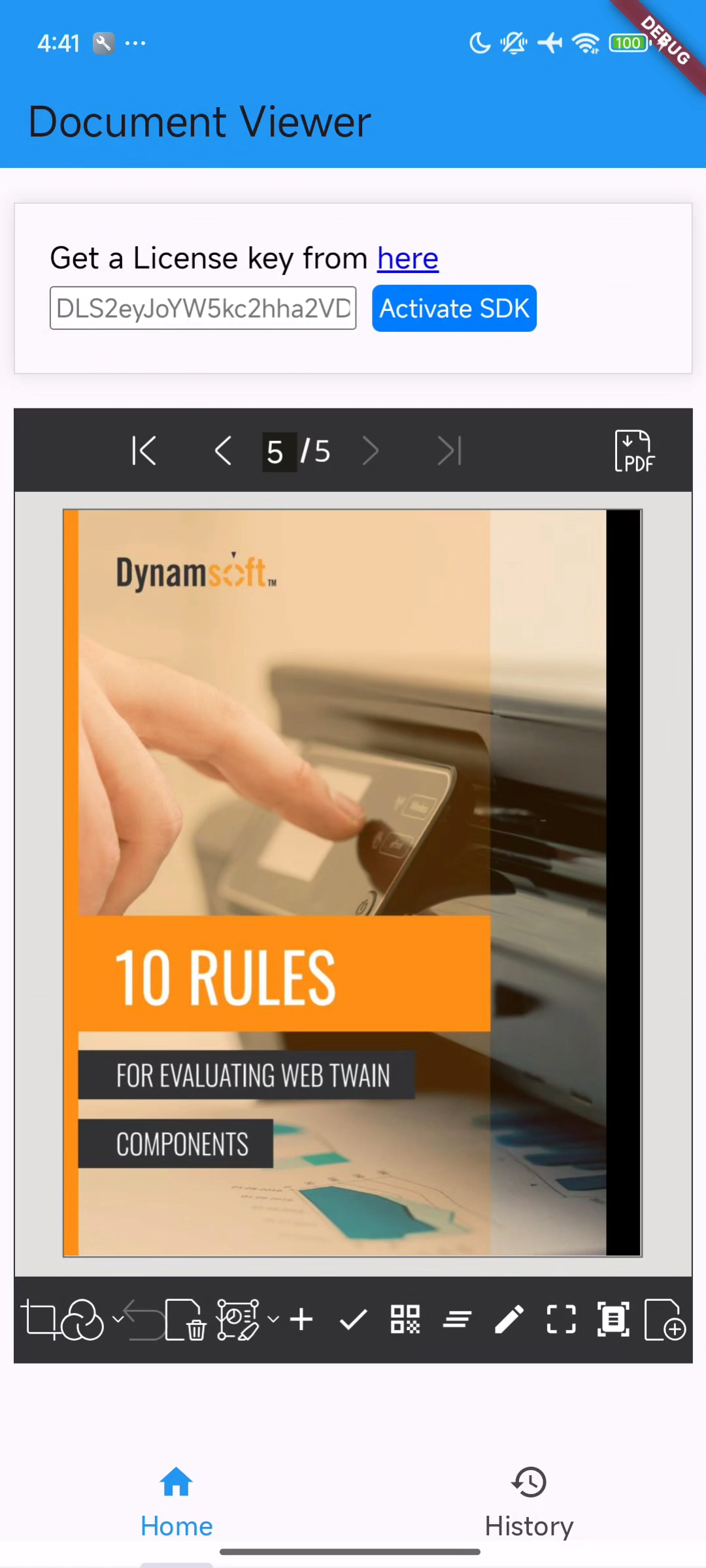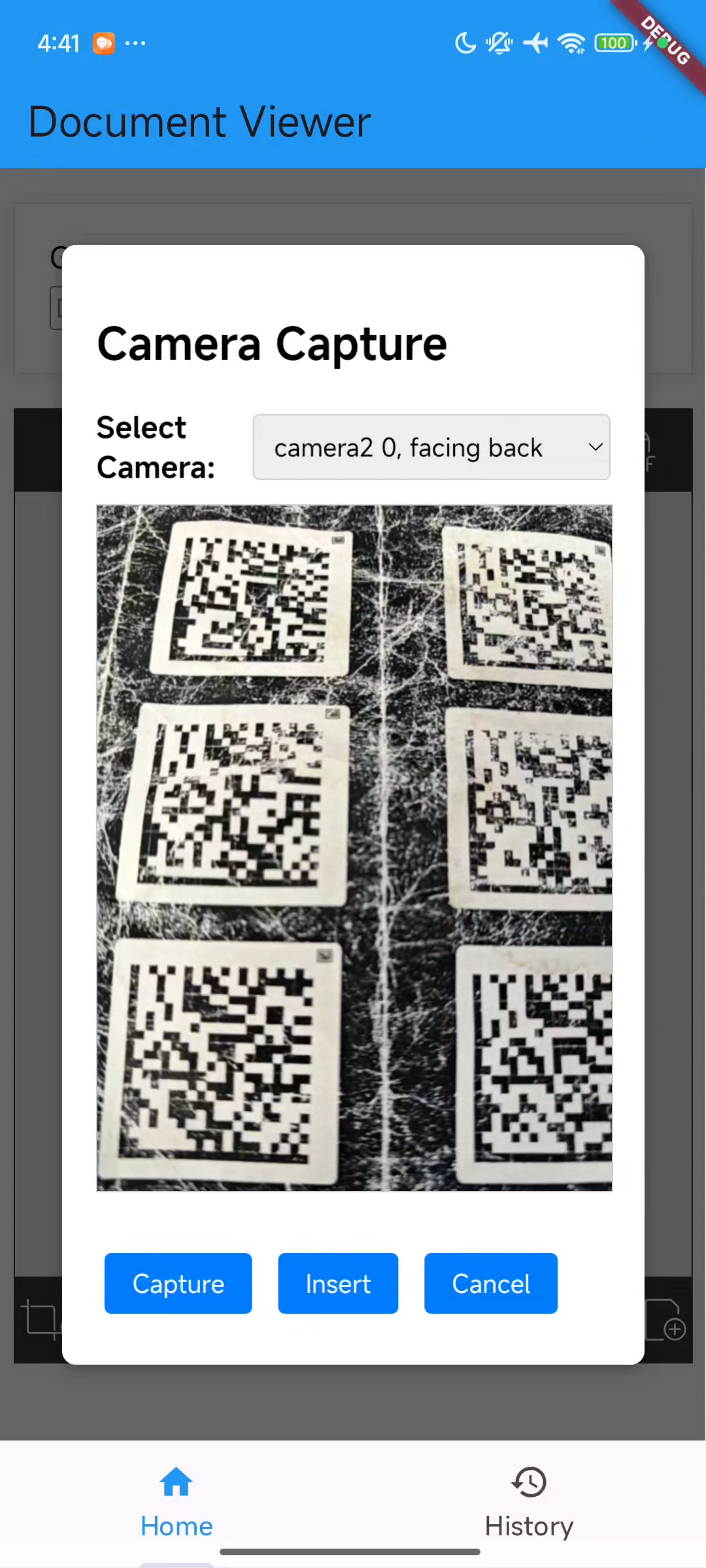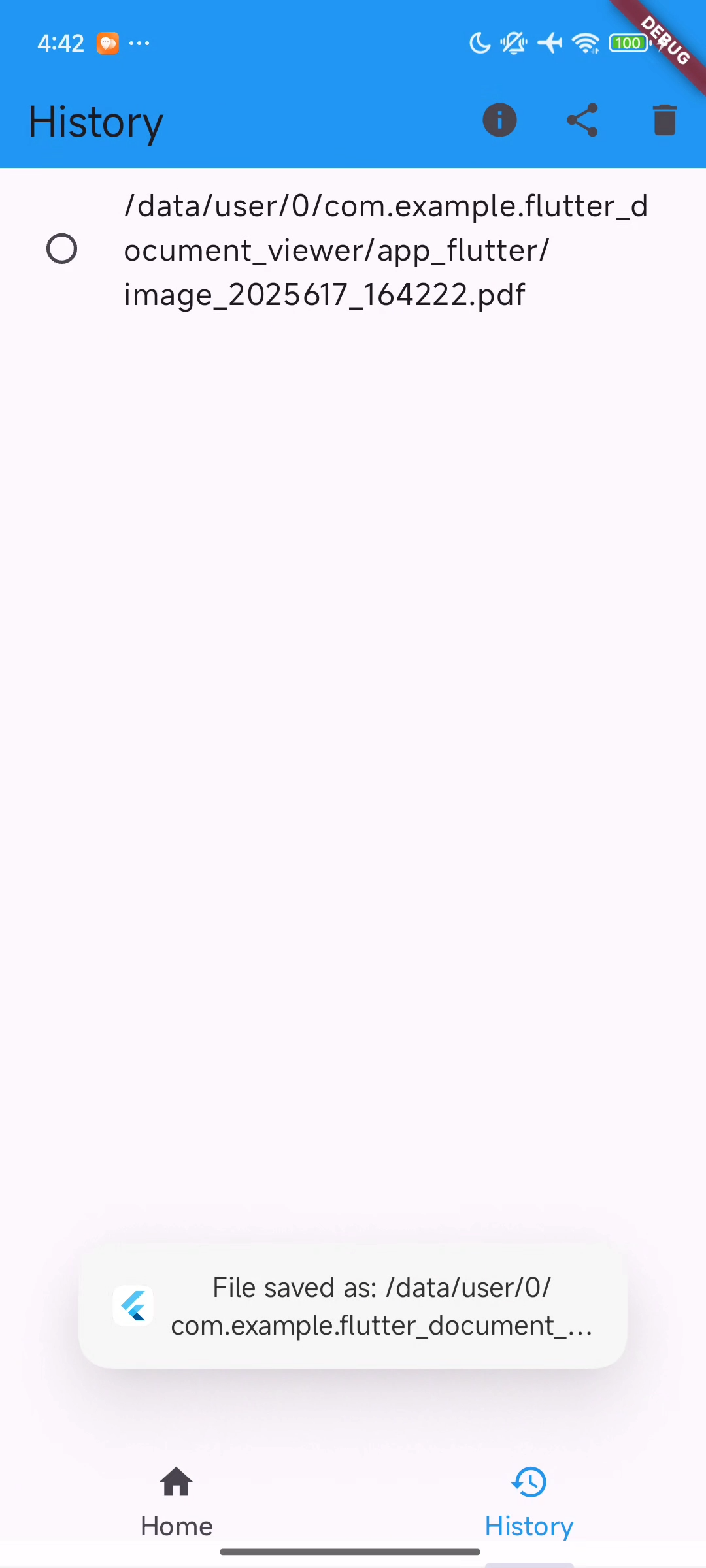How to Build an Android/iOS App to Scan, Edit, and Save Documents with Flutter and HTML5
A mobile document scanner app typically includes features such as document capture, editing, and saving as PDF files. Since we’ve already created a web application with similar functionality using HTML5, JavaScript, and the Dynamsoft Document Viewer SDK,we can integrate that web app into an Android/iOS WebView to quickly develop mobile document scanner apps. In this tutorial, we’ll walk you through the process of creating such a hybrid mobile app using Flutter and HTML5.
Demo: Scan Document and Save PDF with Flutter Mobile App
Prerequisites
- 30-day Trial License: Get a license key to activate the Dynamsoft Document Viewer.
- Dynamsoft Document Viewer: Download the sample code to learn how to scan, capture, edit, and save documents as PDFs. The project will be loaded by the Flutter WebView.
Installing Flutter Dependencies
Add the following dependencies to your pubspec.yaml file:
dependencies:
...
webview_flutter: ^4.13.0
webview_flutter_android: ^4.7.0
webview_flutter_wkwebview: ^3.22.0
image_picker: ^1.1.2
permission_handler: ^12.0.0+1
shelf: ^1.4.2
path: ^1.9.1
shelf_static: ^1.1.3
path_provider: ^2.1.5
fluttertoast: ^8.2.12
share_plus: ^11.0.0
open_file: ^3.5.10
Explanation
webview_flutter: Displays web content inside the Flutter app.webview_flutter_android: Android-specific WebView implementation forwebview_flutter.webview_flutter_wkwebview: iOS WebKit-based WebView implementation forwebview_flutter.image_picker: Selects images from the gallery or camera.permission_handler: Manages runtime permissions.shelf: Serves as a web server for Dart applications.path: Provides utilities for handling file paths.shelf_static: Serves static assets using Shelf.path_provider: Locates commonly used storage paths.fluttertoast: Shows native toast messages.share_plus: Shares files and text using the platform’s share interface.open_file: Opens files with the system’s default app (e.g., PDF viewer).
Loading Local HTML, JavaScript, and CSS Files into Flutter WebView
- Create an
assets/webdirectory at the root of your project and place your HTML, JavaScript, and CSS files there. -
In
pubspec.yaml, register the assets:assets: - assets/web/ -
Load the HTML file in your Flutter code using the
loadFlutterAssetmethod:WebViewController _controller = WebViewController() ..setJavaScriptMode(JavaScriptMode.unrestricted) ..enableZoom(true) ..setBackgroundColor(Colors.transparent) ..setNavigationDelegate(NavigationDelegate()) ..platform.setOnPlatformPermissionRequest((request) { debugPrint( 'Permission requested by web content: ${request.types}', ); request.grant(); }) ..loadFlutterAsset('assets/web/index.html');
Interoperation Between Dart and JavaScript
To save a PDF file from JavaScript memory to the local file system, add a JavaScript channel named SaveFile to the WebViewController, which listens for messages:
_controller =
WebViewController()
...
..addJavaScriptChannel(
'SaveFile',
onMessageReceived: (JavaScriptMessage message) async {
List<dynamic> byteList = jsonDecode(message.message);
Uint8List pdfBytes = Uint8List.fromList(byteList.cast<int>());
String filename = await saveFile(pdfBytes);
Fluttertoast.showToast(
msg: "File saved as: $filename",
toastLength: Toast.LENGTH_LONG,
);
},
)
...
In main.js, convert the blob to a byte array and send it to Dart using SaveFile.postMessage():
savePDFButton.addEventListener('click', async () => {
const fileName = document.getElementById('fileName').value;
const password = document.getElementById('password').value;
const annotationType = document.getElementById('annotationType').value;
try {
const pdfSettings = {
password: password,
saveAnnotation: annotationType,
};
let blob = await editViewer.currentDocument.saveToPdf(pdfSettings);
sendBlobToDart(blob, fileName + `.pdf`);
} catch (error) {
console.log(error);
}
document.getElementById("save-pdf").style.display = "none";
});
function sendBlobToDart(blob) {
const reader = new FileReader();
reader.onload = function () {
const arrayBuffer = reader.result;
const byteArray = new Uint8Array(arrayBuffer);
SaveFile.postMessage(JSON.stringify(Array.from(byteArray)));
};
reader.onerror = function (error) {
console.error("Error reading blob:", error);
};
reader.readAsArrayBuffer(blob);
}
When a message is received on the Dart side:
- Decode the JSON message into a list of dynamic values.
- Convert the list to a
Uint8Listrepresenting PDF bytes. -
Call
saveFile()to save the bytes and return thefilename.Future<String> saveFile(Uint8List pdfBytes) async { final directory = await getApplicationDocumentsDirectory(); String filename = getFileName(); final filePath = '${directory.path}/$filename'; await File(filePath).writeAsBytes(pdfBytes); return filePath; } String getFileName() { DateTime now = DateTime.now(); String timestamp = '${now.year}${now.month}${now.day}_${now.hour}${now.minute}${now.second}'; String name = '$timestamp.pdf'; return name; } - Display a toast message showing the saved
filenameusingFluttertoast.
Handling File Selection on Android
By default, <input type="file"> does not work in Android WebView. Use the following code to handle file selection:
if (_controller.platform is AndroidWebViewController) {
AndroidWebViewController.enableDebugging(true);
(_controller.platform as AndroidWebViewController)
.setMediaPlaybackRequiresUserGesture(false);
(_controller.platform as AndroidWebViewController).setOnShowFileSelector((
params,
) async {
final XFile? image = await _picker.pickImage(
source: ImageSource.gallery,
);
if (image != null) {
return ['file://${image.path}'];
}
return [""];
});
}
Explanation
setOnShowFileSelectoris a method that sets a callback function to handle file selection requests from theWebView.- Inside the callback, it uses the
ImagePickerinstance_pickerto open the device’s image gallery and let the user select an image. - If the user selects an image successfully, it returns an array containing the file
URIof the selected image. - If the user cancels the selection, it returns an array containing an empty string.
Granting Camera Access Permission
To enable camera access:
-
Add permissions in platform-specific files:
android/app/src/main/AndroidManifest.xml
<uses-permission android:name="android.permission.CAMERA"/>ios/Runner/Info.plist
<key>NSCameraUsageDescription</key> <string>This app needs camera access to allow the webpage to use your camera for video input.</string> -
Request the camera permission at runtime in Flutter:
Future<void> requestCameraPermission() async { final status = await Permission.camera.request(); if (status == PermissionStatus.granted) { } else if (status == PermissionStatus.denied) { } else if (status == PermissionStatus.permanentlyDenied) { } } @override void initState() { super.initState(); ... requestCameraPermission(); }
On Android, navigator.mediaDevices.enumerateDevices() returns only the front camera due to WebView security restrictions. This is because loading with file:// lacks a secure context.
Workaround for Android: Use HTTP instead of file://
To enable full camera access:
-
Serve assets via
http://localhost.void main() async { WidgetsFlutterBinding.ensureInitialized(); if (Platform.isAndroid) { final dir = await getTemporaryDirectory(); final path = p.join(dir.path, 'web'); final webDir = Directory(path)..createSync(recursive: true); final files = ['index.html', 'full.json', 'main.css', 'main.js']; for (var filename in files) { final ByteData data = await rootBundle.load('assets/web/$filename'); final file = File(p.join(webDir.path, filename)); await file.writeAsBytes(data.buffer.asUint8List()); } final handler = createStaticHandler( webDir.path, defaultDocument: 'index.html', serveFilesOutsidePath: true, ); try { final server = await shelf_io.serve(handler, 'localhost', 8080); print('Serving at http://${server.address.host}:${server.port}'); } catch (e) { print('Failed to start server: $e'); } } runApp(const MyApp()); }Explanation
- Get the temporary directory and creates a web subdirectory.
- Copy web files (HTML, JSON, CSS, JS) from assets to this directory.
- Create a static file handler to serve these files.
- Start a local HTTP server on port 8080 to serve the content.
-
Load the web page using
..loadRequest(Uri.parse('http://localhost:8080/index.html')):if (Platform.isAndroid) { _controller = WebViewController() ..setJavaScriptMode(JavaScriptMode.unrestricted) ..enableZoom(true) ..setBackgroundColor(Colors.transparent) ..setNavigationDelegate(NavigationDelegate()) ..addJavaScriptChannel( 'SaveFile', onMessageReceived: (JavaScriptMessage message) async { List<dynamic> byteList = jsonDecode(message.message); Uint8List pdfBytes = Uint8List.fromList(byteList.cast<int>()); String filename = await saveFile(pdfBytes); Fluttertoast.showToast( msg: "File saved as: $filename", toastLength: Toast.LENGTH_LONG, ); }, ) ..platform.setOnPlatformPermissionRequest((request) { debugPrint( 'Permission requested by web content: ${request.types}', ); request.grant(); }) ..loadRequest(Uri.parse('http://localhost:8080/index.html')); }
Creating a History Page for Saved PDF Files
To view, share, and delete saved PDFs, add a second tab:
-
In
main.dart, construct the UI with aTabBarViewthat has two tabs:HomeandHistory.@override Widget build(BuildContext context) { return Scaffold( body: TabBarView( controller: _tabController, physics: const NeverScrollableScrollPhysics(), children: [ HomeView(title: 'Document Viewer', controller: _controller), const HistoryView(title: 'History'), ], ), bottomNavigationBar: TabBar( labelColor: Colors.blue, controller: _tabController, tabs: const [ Tab(icon: Icon(Icons.home), text: 'Home'), Tab(icon: Icon(Icons.history_sharp), text: 'History'), ], ), ); } -
Create
home_view.dartto show theWebViewWidget:import 'package:flutter/material.dart'; import 'package:webview_flutter/webview_flutter.dart'; class HomeView extends StatefulWidget { final WebViewController controller; final String title; const HomeView({super.key, required this.title, required this.controller}); @override State<HomeView> createState() => _HomeViewState(); } class _HomeViewState extends State<HomeView> with SingleTickerProviderStateMixin { @override void initState() { super.initState(); } @override Widget build(BuildContext context) { return Scaffold( appBar: AppBar(title: Text(widget.title)), body: WebViewWidget(controller: widget.controller), ); } } -
Create
history_view.dartto display the saved PDF documents:import 'package:flutter/material.dart'; import 'package:open_file/open_file.dart'; import 'package:share_plus/share_plus.dart'; import 'utils.dart'; class HistoryView extends StatefulWidget { const HistoryView({super.key, required this.title}); final String title; @override State<HistoryView> createState() => _HistoryViewState(); } class _HistoryViewState extends State<HistoryView> { List<String> _results = []; int selectedValue = -1; @override void initState() { super.initState(); getFiles().then((value) { setState(() { _results = value; }); }); } Widget createListView(BuildContext context, List<String> results) { return ListView.builder( itemCount: results.length, itemBuilder: (context, index) { return RadioListTile<int>( value: index, groupValue: selectedValue, title: Text(results[index]), onChanged: (int? value) { setState(() { selectedValue = value!; }); }, ); }, ); } @override Widget build(BuildContext context) { return Scaffold( appBar: AppBar( title: Text(widget.title), actions: [ IconButton( icon: const Icon(Icons.info), onPressed: () async { if (selectedValue == -1) { return; } await OpenFile.open(_results[selectedValue]); }, ), IconButton( icon: const Icon(Icons.share), onPressed: () async { if (selectedValue == -1) { return; } await SharePlus.instance.share( ShareParams( text: 'Check out this image!', files: [XFile(_results[selectedValue])], ), ); }, ), IconButton( icon: const Icon(Icons.delete), onPressed: () async { if (selectedValue == -1) { return; } bool isDeleted = await deleteFile(_results[selectedValue]); if (isDeleted) { setState(() { _results.removeAt(selectedValue); selectedValue = -1; }); } }, ), ], ), body: Center( child: Stack( children: [ SizedBox(height: MediaQuery.of(context).size.height), if (_results.isNotEmpty) SizedBox( width: MediaQuery.of(context).size.width, height: MediaQuery.of(context).size.height - 200 - MediaQuery.of(context).padding.top, child: createListView(context, _results), ), ], ), ), ); } }


